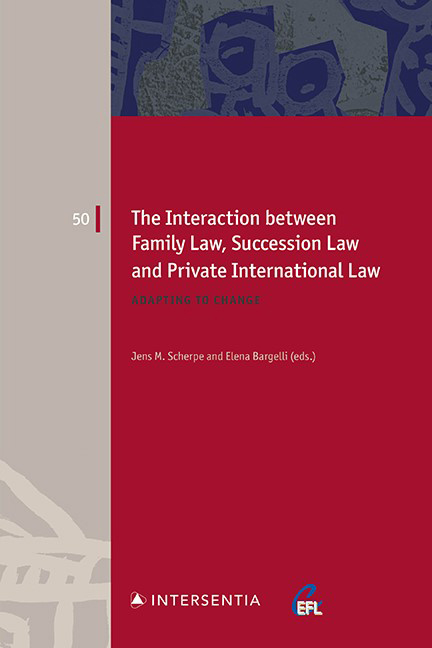Book contents
- Frontmatter
- Acknowledgements
- Contents
- List of Cases
- List of Contributors
- The Interaction between Family Law, Succession Law and Private International Law: An Introduction
- PART I THE IMPACT OF DEVELOPMENTS IN NATIONAL FAMILY LAWS ON EU PRIVATE INTERNATIONAL LAW
- PART II THE IMPACT OF EU PRIVATE INTERNATIONAL LAW ON NATIONAL FAMILY LAWS
- PART III THE IMPACT OF NATIONAL SUCCESSION LAWS ON EU PRIVATE INTERNATIONAL LAW
- PART IV THE IMPACT OF EU PRIVATE INTERNATIONAL LAW ON NATIONAL SUCCESSION LAWS
- Index
- European Family Law Series
The Impact of the European Certificate of Succession on National Law: A Trojan Horse or Much Ado about Nothing?
Published online by Cambridge University Press: 25 May 2021
- Frontmatter
- Acknowledgements
- Contents
- List of Cases
- List of Contributors
- The Interaction between Family Law, Succession Law and Private International Law: An Introduction
- PART I THE IMPACT OF DEVELOPMENTS IN NATIONAL FAMILY LAWS ON EU PRIVATE INTERNATIONAL LAW
- PART II THE IMPACT OF EU PRIVATE INTERNATIONAL LAW ON NATIONAL FAMILY LAWS
- PART III THE IMPACT OF NATIONAL SUCCESSION LAWS ON EU PRIVATE INTERNATIONAL LAW
- PART IV THE IMPACT OF EU PRIVATE INTERNATIONAL LAW ON NATIONAL SUCCESSION LAWS
- Index
- European Family Law Series
Summary
INTRODUCTION
When the European Succession Regulation was adopted in 2012, it was its tailpiece that gained most traction in the European legal doctrine. Besides more conventional chapters on applicable law and jurisdiction in cross-border succession matters, the Regulation also holds the seeds of a harmonisation of substantive succession law. It introduces a European Certificate of Succession, offering a uniform European proof of heirship or a proof of the powers of executors of wills and administrators of the estate. The Certificate produces autonomous legal effects in all Member States, without any special procedure being required.
The Certificate gave rise to many questions regarding its compatibility with national law. Some authors worried that the Certificate would impact national succession and property law beyond its original aim; others saw in it a natural extension of a harmonised lex successionis.
Eight years later, many of the questions surrounding the Certificate have been answered by the Court of Justice of the European Union (CJEU). This chapter takes stock of the impact of the European Certificate of Succession on national law, focusing on the case law of the CJEU.
THE EUROPEAN CERTIFICATE OF SUCCESSION: A PRIMER
AIM AND LEGAL EFFECTS
The settlement of cross-border successions often proves difficult and timeconsuming. For those involved in a cross-border succession, determining their shares, rights and powers according to the applicable law is but the first step. Actually being able to claim their inheritance or to exercise these rights and powers abroad is at least equally challenging. Prior to the European Certificate of Succession, the heirs, legatees, executors of the will or administrators of the estate had to rely on either court orders or national evidentiary documents (‘ national certificates of succession ‘) to demonstrate their status. However, other Member States were generally reluctant to accept foreign certificates of succession and often required the issue of an additional document by their own national authorities. Yet involving an additional foreign authority substantially delayed and complicated the settlement of the estate.
The European Certificate of Succession aimed to overcome these issues by providing for a uniform European evidentiary document.
- Type
- Chapter
- Information
- The Interaction between Family Law, Succession Law and Private International LawAdapting to Change, pp. 157 - 180Publisher: IntersentiaPrint publication year: 2021



